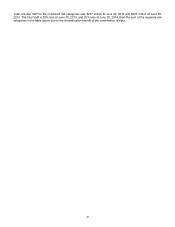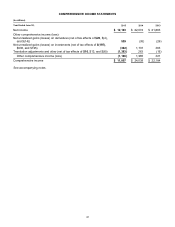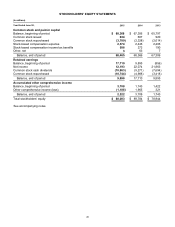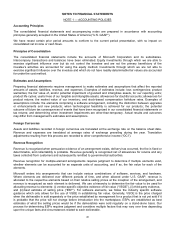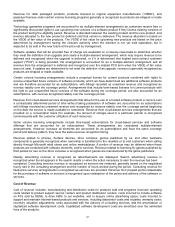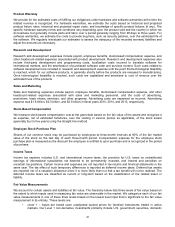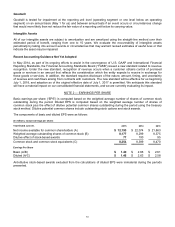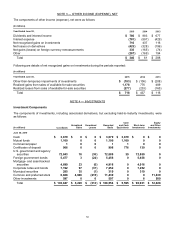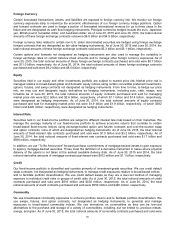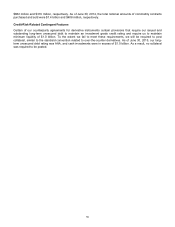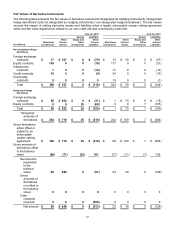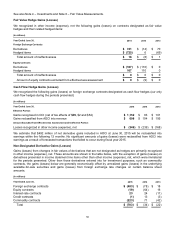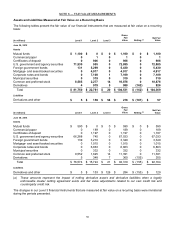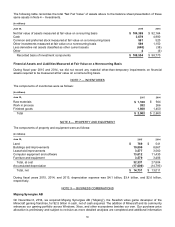Microsoft 2015 Annual Report Download - page 51
Download and view the complete annual report
Please find page 51 of the 2015 Microsoft annual report below. You can navigate through the pages in the report by either clicking on the pages listed below, or by using the keyword search tool below to find specific information within the annual report.
50
likely than not that we will be required to sell the security before recovery. We also consider specific adverse
conditions related to the financial health of and business outlook for the investee, including industry and sector
performance, changes in technology, and operational and financing cash flow factors. Once a decline in fair value is
determined to be other-than-temporary, an impairment charge is recorded to other income (expense), net and a new
cost basis in the investment is established.
Derivative instruments are recognized as either assets or liabilities and are measured at fair value. The accounting
for changes in the fair value of a derivative depends on the intended use of the derivative and the resulting
designation.
For derivative instruments designated as fair value hedges, the gains (losses) are recognized in earnings in the
periods of change together with the offsetting losses (gains) on the hedged items attributed to the risk being hedged.
For options designated as fair value hedges, changes in the time value are excluded from the assessment of hedge
effectiveness and are recognized in earnings.
For derivative instruments designated as cash-flow hedges, the effective portion of the gains (losses) on the
derivatives is initially reported as a component of OCI and is subsequently recognized in earnings when the hedged
exposure is recognized in earnings. For options designated as cash-flow hedges, changes in the time value are
excluded from the assessment of hedge effectiveness and are recognized in earnings. Gains (losses) on derivatives
representing either hedge components excluded from the assessment of effectiveness or hedge ineffectiveness are
recognized in earnings.
For derivative instruments that are not designated as hedges, gains (losses) from changes in fair values are primarily
recognized in other income (expense), net. Other than those derivatives entered into for investment purposes, such
as commodity contracts, the gains (losses) are generally economically offset by unrealized gains (losses) in the
underlying available-for-sale securities, which are recorded as a component of OCI until the securities are sold or
other-than-temporarily impaired, at which time the amounts are reclassified from accumulated other comprehensive
income (“AOCI”) into other income (expense), net.
Allowance for Doubtful Accounts
The allowance for doubtful accounts reflects our best estimate of probable losses inherent in the accounts receivable
balance. We determine the allowance based on known troubled accounts, historical experience, and other currently
available evidence. Activity in the allowance for doubtful accounts was as follows:
(In millions)
Y
ear Ended June 30, 2015
2014 2013
Balance, beginning of period $ 301 $ 336 $ 389
Charged to costs and other 77 16 4
Write-offs (43 ) (51) (57)
Balance, end of period $ 335 $301 $336
Inventories
Inventories are stated at average cost, subject to the lower of cost or market. Cost includes materials, labor, and
manufacturing overhead related to the purchase and production of inventories. We regularly review inventory
quantities on hand, future purchase commitments with our suppliers, and the estimated utility of our inventory. If our
review indicates a reduction in utility below carrying value, we reduce our inventory to a new cost basis through a
charge to cost of revenue. The determination of market value and the estimated volume of demand used in the lower
of cost or market analysis require significant judgment.
Property and Equipment
Property and equipment is stated at cost and depreciated using the straight-line method over the shorter of the
estimated useful life of the asset or the lease term. The estimated useful lives of our property and equipment are
generally as follows: computer software developed or acquired for internal use, three to seven years; computer
equipment, two to three years; buildings and improvements, five to 15 years; leasehold improvements, three to 20
years; and furniture and equipment, one to 10 years. Land is not depreciated.


